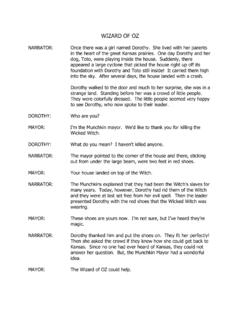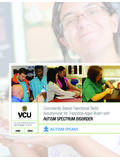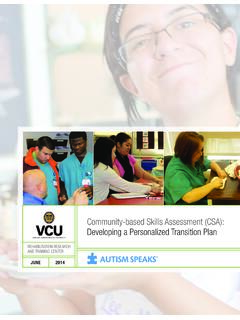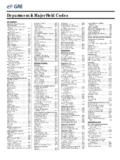Transcription of Strengths-Based Assessment
1 DISCOVER! Strengths-Based AssessmentAnderson & Heyne 2018 DISCOVER! The greatest good you can do for another is not just to share your riches but reveal to him his own. Benjamin Disraeli 19th century statesman and authorWild RoseIf one focuses on the thorn, the rose would be discarded. If one focuses on the bloom, the rose is highly & Heyne 2018 Strengths-Based Assessment Focus is on internal and external strengths Participant is potential waiting to be developed A framework is used to assess and describe strengths Understanding strengths leads to understanding how to plan Ecological approachAnderson & Heyne 2018 Assessment in a Deficits ApproachAssessment in a Strengths ApproachDefines the diagnosis as the problem; questions are pursued related to problems, needs, deficits, and symptoms Defines a holistic portrait: what the participant wants, desires, aspires to, dreams of; participant s talents, skills, and knowledgeSearches for the nature of the participant s problems from the perspective of the professional; analytical Gathers information from the standpoint of the participant s view of the situation.
2 EthnographicIs interrogative in nature Is conversational in natureFocus is on diagnosis to determine level of function Focus is on the here and now, leading to a discussion about the future and how the person has managed so farParticipant is viewed as lacking insight regarding the problem, illness, or diagnosis Participant is viewed as a unique human being who will determine his or her own wants within the environmentAnderson & Heyne 2018 Assessment in a Deficits ApproachAssessment in a Strengths ApproachParticipant is a passive container for interventions as professionals direct decision-making The relationship with the participant is primary to the process, where joint decision-making is keyPlaces the participant in diagnostic or problem categories using generic, homogenous language Strengths Assessment is specific, unique and detailed, individualized to the participantEmphasizes compliance and management of problems and needs, with formal services seen as the solution Explores the rejuvenation and creation of natural helping networks and social supportsControlled by the professional Participant ownershipThe professional dictates, What I think you need to learn and work on The professional asks, What can I learn from you about your life?
3 Anderson & Heyne 2018 Examples of how Assessment shiftsin the strengths approachAssessment Focus-Deficits ApproachAssessment Focus -Strengths ApproachProblems Goals, dreams, aspirations, and strengthsFunctional deficits Functional abilitiesProblems with leisure lifestyle Leisure interests, preferences, talents, skills, knowledge, and goalsLeisure barriers Leisure facilitatorsBehavior problems Social competenceDepression, anxiety, and other negative emotions Positive emotionsStressors Relaxers and soothers (calming inducers)Social isolation and loneliness Social resources, social networks, and community mappingFamily deficits and problems Family strengths, dreams, and goals; family traditions; shared family interests and activitiesAnderson & Heyne 2018 Rationale for Strengths-Based AssessmentTo get to know the individual what makes this person tick? What is meaningful to this person?
4 To begin to develop a positive relationship with the individual and her/his support systemTo establish baselineTo measure outcomesTo provide the right servicesTo focus on solutions, not on problemsAnderson & Heyne 2018 Definition of AssessmentAssessment is a treasure hunt!Therapeutic recreation Assessment is the systematic process of learning about a person, his or her strengths, and his or her aspirations for recreation and well-being. Through Assessment , collaborative planning about the person s future goals and dreams in relation to leisure becomes possible. Anderson & Heyne 2018 Principles in Strength-Based Assessment Assessment ..is Strengths-Based and person-centeredis individualized, based on the participant s world viewfocuses on well-being and quality of life through leisureis based on the aspirations and goals of the participantuses multiple methods and seeks to understand multiple variablesalways involves the participant and his or her circle of supportlooks at the whole person in her or his environment (authentic and ecological) Assessment is a treasure hunt!
5 Anderson & Heyne 2018 Ecological Assessment This is what we know about the person This is what we know about the environment Spiritual Psychological and emotional Leisure Cognitive Social Physical Goals and dreams Friends Expectations Home Community resources Family Opportunities for inclusion Work/ School Anderson & Heyne 2018 Components of Strengths-Based AssessmentWhat is the participant s current situation?What are the participant s internal and external strengths and resources?What will it take to reach the dream?What are the participant s goals, dreams, and aspirations?Where does the participant want to be?Development of a PlanAnderson & Heyne 2018 What to Assess:Use Strengths-Based Models as an Assessment FrameworkAnderson & Heyne 2018 Other Models to Frame AssessmentLeisure & Well-Being ModelICFA nderson & Heyne 2018 Domains for AssessmentAnderson & Heyne 2018 Domains for Assessment :LeisureOutcome for Participants I find enjoyment in my leisure experiences and they positively impact other areas of my life.
6 Anderson & Heyne 2018 Discover Your Passions InterviewInterview questions designed to ascertain what most interests and excites a participant in leisureFor example: What lights you up? When do you seem and feel most alive? What helps you feel a sense of purpose? When do you seem most focused and unaware of distractions? What inspires you to talk or get excited? When was a time you felt at peace with yourself?Anderson & Heyne 2018 Let s Try the Passions InterviewWith your neighbor, interview each other with a selection of the questions that you choose!Anderson & Heyne 2018 Inclusivity Assessment ToolMeasures the physical and social aspects of inclusion at a recreation agencyInclusion U Online training qualifies you as a CIA (Certified Inclusivity Assessor) to use the IATA nderson & Heyne 2018 IAT Checklists, User Manual, and Tool Kit60 & Heyne 2018 Inclusive recreation Resource Center Inclusion U Online Become a Certified Inclusivity Assessor What is Inclusion U Online?
7 An online training where you learn the foundations of inclusion and how to use the Inclusivity Assessment Tool Nine modules that you complete online at your own pace Take the final exam to become a Certified Inclusivity Assessor (CIA) 10 contact hours of training What is a Certified Inclusivity Assessor? A Certified Inclusivity Assessor (CIA) has completed Inclusion U Online and is trained to use the Inclusivity Assessment Tool Use the Inclusivity Assessment Tool to assess a recreation site for its physical and social inclusion Only CIAs can use the Inclusivity Assessment Tool, developed by the Inclusive recreation Resource Center What do I get when I register? 10 hours of training that you can access for as long as you like The Inclusivity Assessment Tool User Manual eBook A CIA card and a certificate of completion Access to the online/electronic and PDF versions of the Inclusivity Assessment Tools and specialty checklists Access to the CIA App Assessment tool for mobile data entry Ability to register an unlimited number of people in the 3-hour online Inclusion Ambassador Training for free How do I register for Inclusion U Online?
8 Go to the Inclusive recreation Resource Center s website at The registration process is online just have your credit card ready The cost of Inclusion U Online is $ for an individual Discounted group rates are available and you can be a team leader (see website for details) You earn 1 full CEU for the training (10 hours), pre-approved for CE credit by NCTRC | | Box 2000, SUNY Cortland, Cortland, NY 13045 | 607-753-4833 EVERYTHING YOU NEED TO KNOW Inclusive recreation Resource CenterInclusion U OnlineInclusion U Online teaches you about inclusion and how to be a Certified Inclusivity Assessor (CIA)! Once you complete Inclusion U, you are able to complete inclusivity assessments and submit the results to the IRRC online recreation database. As a CIA, you can also enroll an unlimited number of people in the free Inclusion Ambassador help people of all abilities play wherever they Assessment ToolWith the user-friendly Inclusivity Assessment Tool, you can assess physical accessibility and programmatic and administrative inclusion at recreation facilities and programs.
9 Inclusion Ambassador TrainingAll recreation programs and facilities that are assessed using the Inclusivity Assessment Tool are entered into the online database that is searchable by Google map, activity, venue, and location. The database helps people with disabilities and their families and friends better plan their to Help You Achieve InclusionWe provide help and support in improving recreation accessibility and inclusion for people with disabilities in parks, programs, or facilities. Our tools include apps like our Inclusion Toolkit app, IRRC recreation Finder app, and CIA recreation DatabaseThe Inclusion Ambassador Training, a three-hour online training, teaches you how to include people of all abilities in recreation , parks, camps, and other aspects of your life. You earn badges throughout the fun | | Box 2000, SUNY Cortland, Cortland, NY 13045 | 607-753-4833 Domains for Assessment :Psychological/EmotionalOutcom e for Participants I feel happy and perceive I am in control of my life.
10 Anderson & Heyne 2018 Positivity Test20-item scale to help people measure the level of positive to negative emotion they experience, called their positivity ratio Anderson & Heyne 2018 Take two minutes to complete the Positivity Self Test now. Your score provides a snapshot of how your emotions of the past day combine to create your positivity ratio. Instructions: How have you felt in the past day? Look back over the past day ( , from this time yesterday up to right now). Using the 0-4 scale below, indicate the greatest degree that you've experienced of each of the following feelings. 0 = Not at all 1 = A little bit 2 = Moderately 3 = Quite a bit 4 = Extremely What is the most amused, fun-loving, or silly you felt? What is the most angry, irritated, or annoyed you felt? What is the most ashamed, humiliated, or disgraced you felt? What is the most awe, wonder, or amazement you felt?







